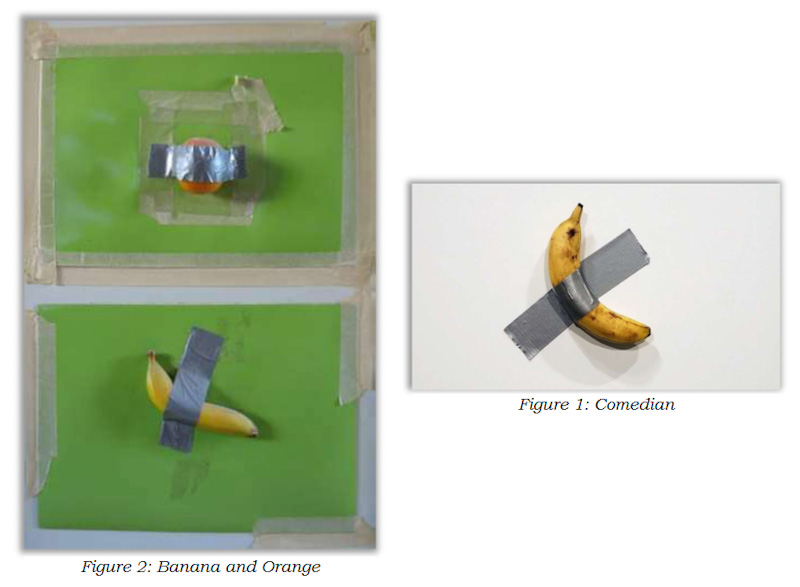Banana-on-wall artwork didn't infringe another artist's work, federal judge says

Images from Judge Robert N. Scola Jr.'s June 12 opinion.
A federal judge in Miami has tossed an artist’s lawsuit contending that his copyrighted artwork consisting of a plastic orange and a banana duct taped to a green panel was infringed by a second banana display.
U.S. District Judge Robert N. Scola Jr. of the Southern District of Florida ruled against pro se plaintiff Joe Morford, who developed his artwork entitled Banana and Orange in California in 2001. He sued after Italian artist Maurizio Cattelan displayed a banana duct taped to a wall at the Art Basel Miami show in 2019.
Cattelan charged $120,000 for his work called Comedian to further demonstrate its absurdity, according to Scola’s June 12 opinion.
Cattelan had testified that his inspiration for Comedian was drawn from a work that he created for New York Magazine in 2018 that depicted a banana hanging from a billboard with red duct tape. He said he was not aware of Banana and Orange and had not heard of Morford before he filed the suit.
Morford argued that Banana and Orange could have been seen because it was posted on Facebook, in a YouTube video and in a blog post.
But Scola said access to a copyrighted work can’t be proven simply because a defendant had some possible opportunity to review it.
“A work’s mere presence on the internet alone,” Scola said, “is insufficient to demonstrate access without some additional proof that the defendant had some relevant nexus to the plaintiff’s work or that the plaintiff’s work enjoyed some meaningful level of popularity.”
The evidence shows that Morford’s Banana and Orange remained “a relatively obscure work with very limited publication or popularity,” according to Scola.
Scola said his ruling on access to Banana and Orange was all that was needed to toss the suit. But he cited two more reasons for dismissing the case: The legal similarities between the artworks are lacking, and Cattelan offered proof of his independent creation of Comedian.
Morford can’t claim a copyright in the idea of affixing a banana to a vertical plane using duct tape, but he can copyright aspects of his work, Scola said. Those aspects include the green panel to which his plastic fruit is taped, the duct tape border, the angle of the banana and the placement of its stalk.
The only common feature is the placement of the banana stalk on the left-hand side of the artwork, which isn’t significant enough to support a finding of infringement, Scola said.
“The lack of similarity between the two works is now clear and inescapable,” he concluded.
Reuters, Axios and Law360 are among the publications with coverage of the ruling.
Write a letter to the editor, share a story tip or update, or report an error.



